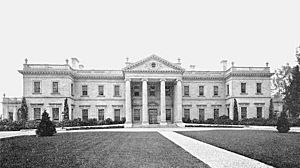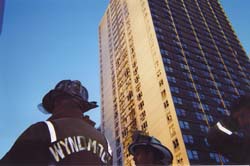Wyndmoor, Pennsylvania facts for kids
Quick facts for kids
Wyndmoor
|
|
|---|---|
| Country | United States |
| State | Pennsylvania |
| County | Montgomery |
| Township | Springfield |
| Area | |
| • Total | 1.65 sq mi (4.26 km2) |
| • Land | 1.65 sq mi (4.26 km2) |
| • Water | 0.00 sq mi (0.00 km2) |
| Elevation | 420 ft (130 m) |
| Population
(2020)
|
|
| • Total | 5,853 |
| • Density | 3,558.05/sq mi (1,373.45/km2) |
| Time zone | UTC-5 (EST) |
| • Summer (DST) | UTC-4 (EDT) |
| Area code(s) | 215, 267, and 445 |
| FIPS code | 42-86776 |
Wyndmoor is a community located in Springfield Township, Montgomery County, Pennsylvania, United States. It is known as a census-designated place (CDP), which means it's a special area defined by the government for counting people. In 2020, about 5,853 people lived here. Wyndmoor shares its ZIP code, 19038, with nearby towns like Glenside, North Hills, and Erdenheim.
Contents
Geography of Wyndmoor
Wyndmoor is located at coordinates 40.082810° N, 75.191829° W. This spot is just north of Philadelphia.
The United States Census Bureau says that Wyndmoor covers an area of about 1.6 square miles (4.26 square kilometers). All of this area is land.
People of Wyndmoor
| Historical population | |||
|---|---|---|---|
| Census | Pop. | %± | |
| 1990 | 5,682 | — | |
| 2000 | 5,601 | −1.4% | |
| 2010 | 5,498 | −1.8% | |
| 2020 | 5,853 | 6.5% | |
| U.S. Decennial Census | |||
In 2010, most of the people living in Wyndmoor were White (73.5%). There were also many Black or African American residents (18.8%), and smaller groups of Asian (3.3%), Native American, and other backgrounds. About 2.5% of the population had Hispanic or Latino family roots.
In 2000, there were 5,601 people living in Wyndmoor. They lived in 2,144 homes, and 1,460 of these were families. The average home had about 2.39 people, and the average family had 2.93 people.
The community had a mix of ages. About 20.3% of the people were under 18 years old. About 26.6% were 65 years or older. The average age in Wyndmoor was 46 years old.
Getting Around Wyndmoor
Wyndmoor has a train station called Wyndmoor train station. Even though it's called Wyndmoor, it's actually in the nearby Chestnut Hill area of Philadelphia.
You can also get around Wyndmoor using SEPTA buses. The 77 and L bus routes serve the area.
History of Wyndmoor

The founder of Pennsylvania, William Penn, set aside the land that is now Springfield Township as one of his family's first estates in the 1680s.
The name "Wyndmoor" has an interesting past. Before it was called Wyndmoor, the community had other names like "Bungtown," "Spring Village," and "Tedyuscung." "Tedyuscung" was named after a Native American leader, Teedyuscung. You can find a statue of him overlooking the Wissahickon Creek in Valley Green.
The name "Wyndmoor" might have come from the Heebner family, who gave land for the Reading Railroad station. Or, it could have been the name of a large estate owned by Randal Morgan around 1900. He became rich from oil. Eventually, "Wyndmoor" became the name for the whole residential area east of Stenton Avenue.
Wyndmoor was once home to Whitemarsh Hall, a huge estate owned by a banking executive named Edward T. Stotesbury. This estate was about 300 acres (1.2 square kilometers). In the late 1940s, the estate became a housing development. The mansion, which had 147 rooms, was torn down in 1980. However, some of its large columns and statues can still be seen in Wyndmoor neighborhoods today.
Two other important historical buildings in Wyndmoor, the Stotesbury Club House and the John Welsh House, are listed on the National Register of Historic Places. This means they are recognized as special historical places.
Wyndmoor Hose Company: Firefighters and Emergency Help
How it Started (20th Century)
The Wyndmoor Hose Company No. 1 is a local fire department that started in 1906. It grew from a small fire brigade at the Nelson Valve Company, a factory that made hydraulic valves. The factory needed its own fire team because of the dangerous machines used there. Soon, local residents volunteered to help, and the company bought a hand cart and hose.
By 1909, they had bigger carts pulled by horses. Horses were a bit of a problem, so they even offered a reward to the first horse team that arrived when the alarm sounded! This led to some friendly competition among the horse teams.
In the 1920s, the fire company moved to a new building on Queen Street, which was their home for almost 50 years. They bought modern fire trucks, including two Hale Pumpers in 1927 and a ladder truck in 1940. To help pay for these expensive new trucks and equipment, the fire company held large fairs for many years. These events helped them keep their services up-to-date.
The Wyndmoor Hose Company is made up entirely of volunteers. Over fifty members are ready to respond to emergencies day and night, every day of the year.
In the late 1990s, the fire company decided to add emergency medical services. They bought a Quick Response Service (QRS) unit. This unit carries basic first-aid equipment to help people until the Springfield Ambulance Association arrives.
Modern Day (21st Century)
After the September 11, 2001, terrorist attacks, the Wyndmoor Hose Company sent a team to Ground Zero to help. After this, they also expanded their Hazardous Materials (HazMat) operations. Wyndmoor now works with HazMat 919 to provide decontamination services for Eastern Montgomery County. They bought a larger trailer for more equipment and all members received advanced training in handling hazardous materials.
Today, the Wyndmoor Hose Company No. 1 is ready for almost any emergency. They have modern vehicles, including a 2007 Pierce Rescue truck and a Ford F550. They also have a boat for water rescues and various trailers. In May 2019, they received a new 2019 Rosenbauer truck with a 55-foot aerial boom, called Snorkel 82. Whether it's a building fire, a car accident, a hazardous material spill, or a medical emergency, Wyndmoor's team is well-trained and ready to act.
Schools in Wyndmoor
- La Salle College High School
- The Institutes for the Achievement of Human Potential (IAHP)
Famous People from Wyndmoor
Many interesting people have lived in Wyndmoor, including:
- Samuel L. M. Barlow (1892–1982), a composer, pianist, and art critic who studied at Harvard University.
- Ray Benson (born 1951), a country music star and co-founder of the band Asleep at the Wheel.
- Jim Cramer (born 1955), a TV host for the show Mad Money on CNBC.
- Steven Kampmann (born 1947), an actor, writer, and director.
- Robert L. McNeil, Jr. (1915–2010), who helped create the medicine Tylenol.
- David Montgomery (1946-2019), who was a part-owner and president of the Philadelphia Phillies baseball team.
- Otto Frederick Nolde (1899–1972), a pioneer in human rights.
- Lucky Oceans (born 1951), a pedal steel guitarist and co-founder of Asleep at the Wheel. He later became a broadcaster in Australia.
- Edward T. Stotesbury (1849–1938), a very successful investment banker who was a partner in famous companies like Drexel & Co. and J. P. Morgan & Co. for over 55 years.
See also
 In Spanish: Wyndmoor para niños
In Spanish: Wyndmoor para niños





